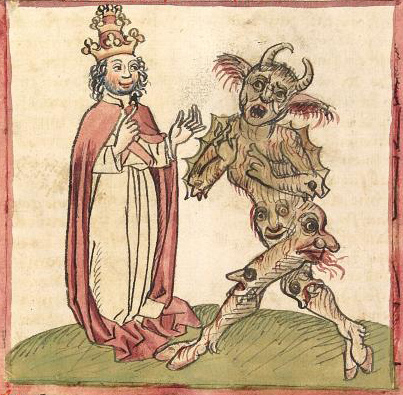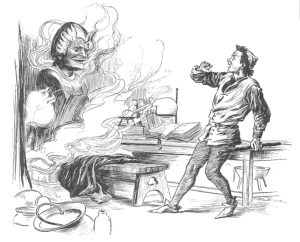
ON COCKATRICES AND COCCINELLES
In my lifetime of eclecticism, I have acquired a degree in electrical engineering, and also one in medieval history. Feel free to recommend another way of blending a love of math and Latin. Needless to say, I have very little use for either degree in my current rather bland corporate pursuits, but they do occasionally make for good conversation.
Speaking of medieval times, the more one learns about this millennium-old period (roughly from the 5th century to the 15th century), the more one comes to appreciate it as THE definitive era in the formation of the West. From the ashes of the Western Roman Empire, Europeans have built something new and unique.
Our entire notion of the “Middle Ages” as something on-the-way-to-something, something that is in-between is highly misleading. It represents the patronizing approach of the luminaries of the Renaissance who by reviving some of the thinking and arts of the classical world, had decided to cram together 1000 years of history as the “Middle Ages.”
That patronizing approach continues. When we don’t play video games in which the Middle Ages become a Lord of the Rings like adventure, we think about that era as a dark age of zealotry and mass ignorance.
But are we that different from our childish fantasies of the middle ages? Let’s think this through.
Belief in strange beasts was rather common in medieval Europe. In an age where the flow of information was slow and no recording or photography was available, everything was a sort of telephone game. Things could easily become very florid and exotic. A large snake observed in the year 900 would become a “Cockatrice” by 1200, a rooster-dragon beast with the power to kill with its gaze.

Unless you love D&D this sure seems silly, but hold on. What about a belief in a magical beast that can change its gender by choice? Not only can it switch between male and female at will, but it can also invent new genders, heretofore unknown in traditional biology. It can even have no gender at all or be “fluid” about the whole thing.
Yes, the modern “trans” is as silly as the cockatrice of the Middle Ages, and if anything not at all as cool. In Israeli non-PC slang, we used to call such cross-dressers “Coccinelles.”

Our medieval forefathers were sometimes prone to strange periods of panic. Approaching the year 1000, there spread a belief across Europe that the Apocalypse, to be followed by the Second Coming, was finally about to happen. After all, it had been almost 1000 years since the birth of Christ.
Surviving evidence is sparse, but what little survives speaks of apocalyptic expectations, sights of strange fires in the sky, a belief that the end was nigh, and outbreaks of panic.
Such Y1K panic may seem rather infantile. But then again, think again. Does the Left’s belief that the world is coming to an end in 10 years make more sense? Is the angry and sometimes violent panic regarding the climate, despite scientific evidence that points to rather gradual and minor changes, less apocalyptic than the belief of medieval Hungarian peasants that the Antichrist was about to be born?
What’s sillier? Blaming every flood born out of government ineptitude on “climate change,” or blaming every war and famine on the Antichrist?
The Ars Notoria, or the Notory Art of Solomon, was a medieval text to introduce the educated reader to the world of magic and spells. For instance, an incantation to help the sick: “Si iacuerit languens, assistens coram eo dicas ter cum magna reuerentia” (if a man shall lie sick and languising, let you say this openly to him three times, with great reverence). The first part goes:
Ihesus fili: Dominus incomprehensibilis [Jesus the Son, incomprehensible Lord]: Ancor, Anacor, Anylos Zohorna, Theodonos, helyotes phagor, Norizane, Corichito, Anosae, helse, Tonope phagora.
Ars Notoria
Does it work? Feel free to give it a try. As modern people we may feel a tad of skepticism towards such whirlpools of words, but how different is this from the writings of woke superstar Robin Diangelo? She promises a cure to our innate “racism” if only we become aware of our white “fragility” which is wreathed with privilege and guilt. Here’s one of Diangelo’s incantations for not being racist. Or for being racist. Or something:
Unfortunately, aversive racism only protects racism, because we can’t challenge our racial filters if we can’t consider the possibility that we have them. Of course, some whites explicitly avow racism. We might consider these whites actually more aware of, and honest about, their biases than those of us who consider ourselves open-minded yet who have rarely thought critically about the biases we inevitably hold or how we may be expressing them.
From White Fragility by Robin Diangelo.
Medieval times were also not without strange political witch hunts. Pope Sylvester (999-1003), an otherwise scholarly and virtuous man, was accused of dealings with the Devil, accompanied by the construction of a demonic head for midnight conversations.
Again, it may sound a bit rich to modern ears, but how about the idea that President Donald Trump had partied in Russia with prostitutes while engaging in mutual urination? Instead of dealing with the Devil, Trump was accused of taking orders from Vladimir Putin without much evidence beyond the hysterical tribunal of Representatives Adam Schiff and Nancy Pelosi.

And so, it appears that the joke is on us moderns. Our ancestors had lived in a world that was yet but darkly known. We, however, equipped with splendid wealth, immeasurable comforts, and the full rigor of the scientific method, seem to fall into very similar traps of hysteria and nonsense. What is our excuse?

Follow us on Twitter!
And sign up for updates here!